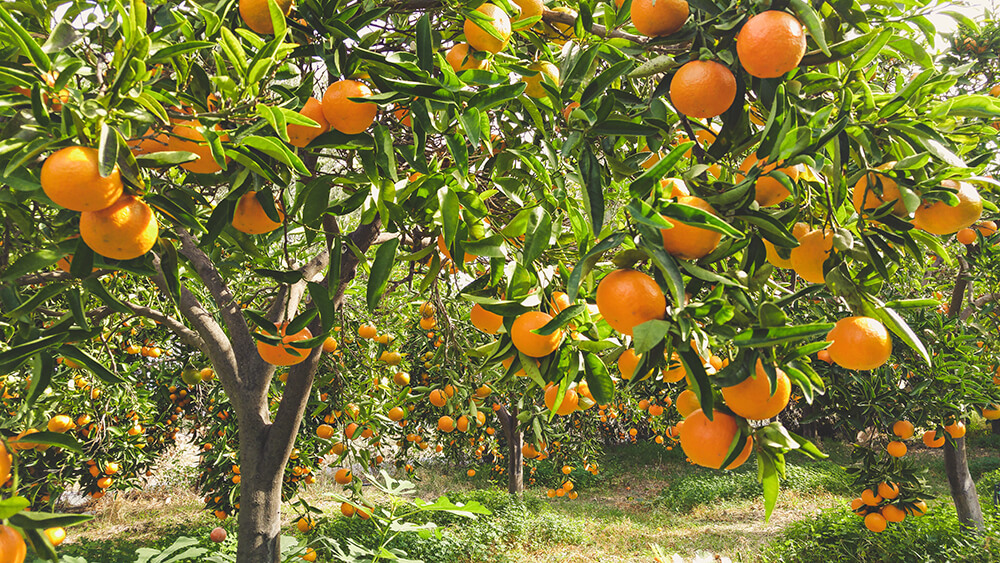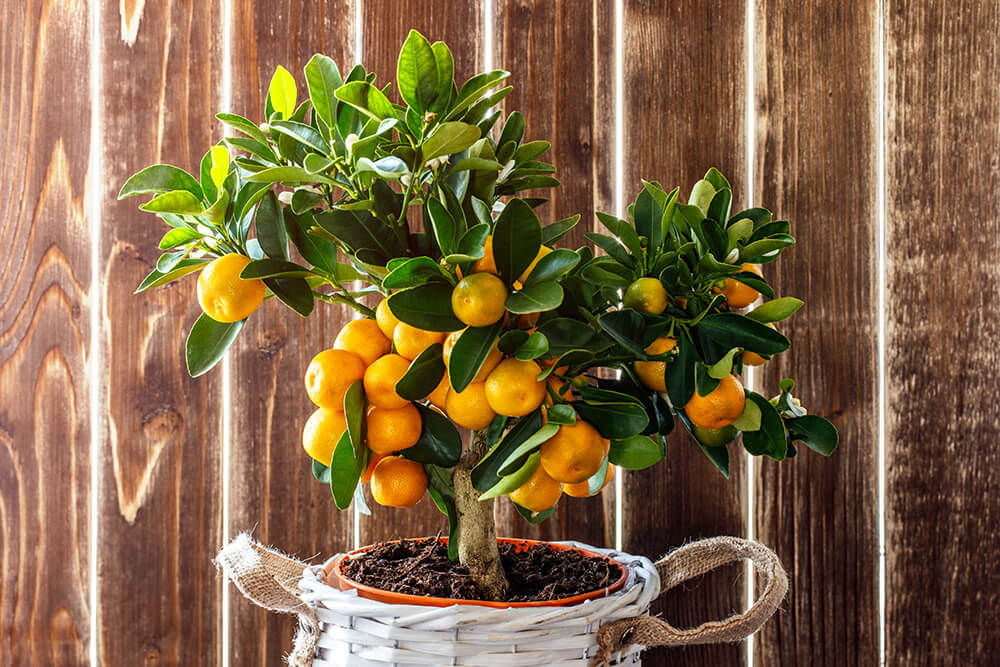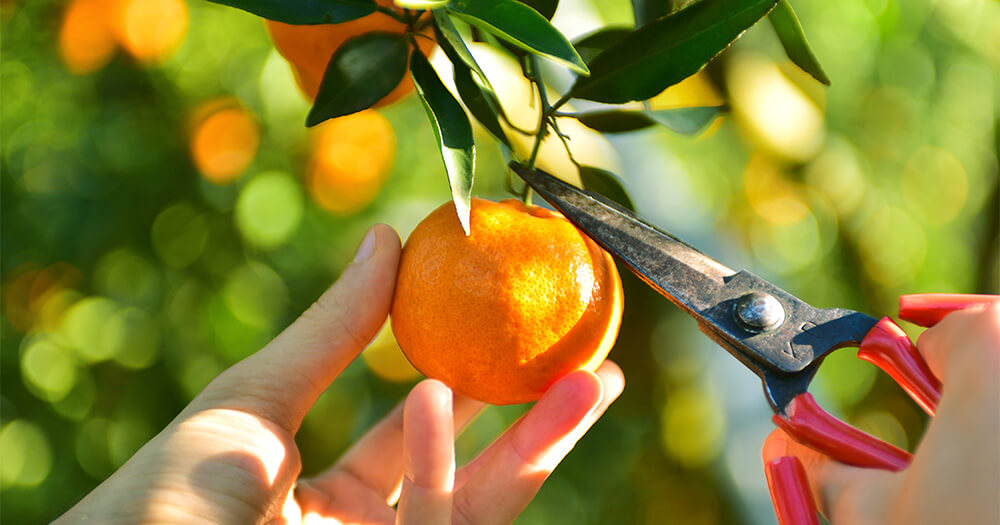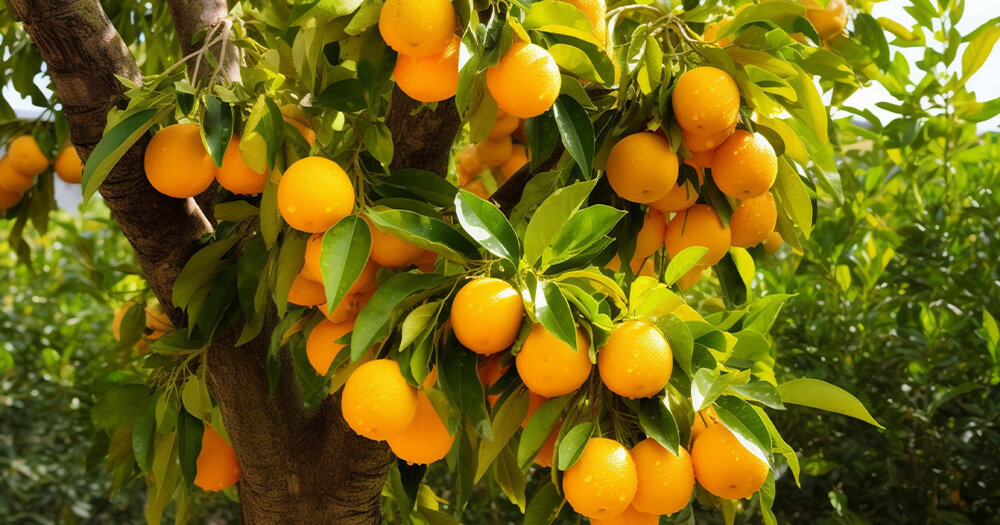The mandarin tree, scientifically known as Citrus reticulata, is a small, rounded citrus tree that produces easy-peeling, super-sweet citrus fruit. It is a popular choice for home gardens due to its delicious flavor, ease of peeling, and versatility in various culinary applications. This guide covers all the basics of mandarin tree care.
Key Takeaways
- Mandarine trees need a sunny location in your yard where they will receive at least 6 hours of direct light daily.
- When you harvest a piece of fruit, you should gently twist it off so you don’t damage the branch.
- Young mandarine trees require more water than established ones.
Mandarin oranges, including varieties like clementines, tangerines, and satsumas, are known for their bright orange color, sweet taste, and seedless nature. They are a great snack, can be used in salads, marinades, and desserts, and make excellent juice. They can be used in several savory applications, too, like mandarine glazed pork.
These trees can grow to a mature height of 25 feet, but for semi-dwarf varieties that reach a height of about 8-10 feet. The leaves are rich green, oval, or lance-like, and the plant bears small white five-pointed petals that grow in clusters. The fruit is smaller than a typical orange and has a deep orange rind, which is thin and easy to peel.
Managing Mandarin
If you’re thinking about mandarines for your landscape, you need a space for it with partial to full sun (at least 6 hours daily). Basic care includes keeping it pruned, fertilized and watching for pests.
While it’s hard to wait, fruit development occurs in summer, and harvesting takes place in late fall and early winter. Mandarin trees start producing a significant amount of fruit when they reach around five years old and can continue to be productive for many years. The fruit is typically harvested when it is entirely orange. This is the moment. Taking a fresh fruit from the tree and enjoying the sweetness.
A Name That Makes Sense: The name “mandarin” is believed to have originated from the bright orange robes worn by Chinese government officials during the Qing Dynasty, which resembled the color of the fruit.
Mandarin Tree Care

Besides proper lighting, Mandarin trees prefer well-draining soil that is rich in organic matter. The pH level should be between 6 and 7. If the soil is heavy or poorly drained, consider amending it with organic matter or planting the tree in a raised bed.
For watering these trees thrive on deep watering during hot, dry periods. When you water the tree deeply, it ensures the water reaches the root zone. Avoid overwatering, as it can lead to root rot. Monitor the soil moisture and adjust watering accordingly.
Fertilization: Mandarin trees benefit from regular fertilization to ensure healthy growth and fruit production. Use a balanced citrus fertilizer or a specially formulated fertilizer for citrus trees. Follow the recommended application rates and timing to avoid over-fertilization, which can harm the tree.
There’s also mulching: Create a layer of organic mulch around the base of the tree. Keep it a few inches away from the trunk to prevent rotting. Mulching helps conserve soil moisture, suppress weeds, and regulate soil temperature.
Mandarin trees (Citrus reticulata) are native to Southeast Asia, specifically China and Vietnam. They have been cultivated for thousands of years and are widely grown in various parts of the world today. Citrus Trees: Mandarin trees belong to the citrus family, Rutaceae. They are closely related to other citrus fruits such as oranges, lemons, and grapefruits.
Basic Needs of Mandarin Trees
Mandarins are like any other plant. They have specific needs regarding sun, watering, fertilization, pruning, pest control, mulching, etc. This article covers these topics individually. If possible, consult local gardening resources or experts for specific care instructions tailored to your region and the specific variety of Mandarin trees you are growing.
The Mandarine Allure: Mandarine oranges have easily peelable skin, making them a “go-to” portable snack. The segmented fruit separates easily. They are commonly referred to as “cloves” or “pods.” These segments offer sweet and juicy flesh. Better still, there are seedless varieties, making eating or cooking them far more manageable. They’re also good for you. Mandarin oranges are an excellent source of vitamin C, offering a healthy dose of this essential nutrient.
Mandarin Trees for Your Landscape
When selecting a mandarin tree for your yard or garden, consider factors such as climate suitability, size restrictions, and personal flavor preferences. It’s always a good idea to consult with local nurseries or agricultural extension offices to determine which varieties thrive best in your specific region.
- Clementine: Clementines are one of the most beloved Mandarin varieties. They are small, seedless, and exceptionally sweet. The tree is typically small to medium-sized, making it suitable for smaller spaces.
- Satsuma: Satsuma mandarins are known for their easy-peeling, loose skin, and sweet-tart flavor. They are cold-hardy and can withstand temperatures down to 20°F (-7°C). Satsuma trees are compact and can be grown in containers.
- Tango: Tango mandarins are a newer variety that has gained popularity for its exceptionally sweet and juicy fruit. The tree is small to medium-sized and can thrive in various climates.
- Owari: Owari mandarins, also called the Christmas mandarins, are widely grown for their delicious, seedless fruit. They have a rich flavor and thin, easy-to-peel skin. The tree is small and is suitable for both container and ground planting.
- Honey Murcott: Honey Murcott mandarins are known for their high sugar content, making them extremely sweet and flavorful. They have a deep orange color and a slightly bumpy rind. The tree is medium-sized and produces abundant fruit.
- Dancy: Dancy mandarins are an older variety with a rich history. They have a tangy-sweet flavor and are often used for juicing. The tree is medium-sized and can tolerate colder temperatures.
- Owari Satsuma: This variety is considered the hardiest of all mandarins and is known for its seedless fruit and cold tolerance. It is a slow-growing tree but well worth the wait.
- Kishu: This Japanese variety is small, seedless, and easy to peel. It is a compact tree, making it suitable for smaller landscapes or container gardens.
- Clementine: Clementines are sweet and juicy mandarins that can have some seeds if planted alongside other mandarins. They are a popular choice for their flavor and ease of peeling.
- Gold Nugget: The Gold Nugget mandarin is known for its rich gold color, easy peeling, and seedless fruit. It has an extended harvest period, making it a great choice for continuous enjoyment.
- Pixie: The Pixie mandarin is a small-sized tree with seedless fruit that is easy to peel. It has a delightful flavor, making it a favorite among children and snack enthusiasts. It also has a long harvest window, extending into June.
- Page: The Page mandarin is a seedless fruit that is a cross between a clementine and a Minneola tangelo. It has a rich flavor and is known for its deep orange color. It ripens in December, making it a perfect treat for the holiday season.
Mandarin oranges hold special significance in various cultural rituals, celebrations, and traditions. Overall, they represent a positive change in fortunes. In Chinese, these have associations with good luck and prosperity, so they are often exchanged as gifts during the Lunar New Year. The Chinese language is filled with homophones, and in Mandarin, the word for “mandarin” sounds like wealth!
If you give someone mandarin oranges on any special day, it acts as a wish for happiness and prosperity. You can take them as gifts for the host of a party, showing respect, appreciation, and blessings.
Watering Techniques for Mandarin Orange Trees
Remember, it’s essential to consider the specific conditions of your location and the characteristics of your Mandarin tree when establishing a watering schedule. Factors such as rainfall, humidity, soil type, and tree size can affect watering needs. Always monitor the soil moisture and adjust the watering schedule accordingly to maintain optimal hydration for your Mandarin tree. Here are some tips:
- Young Trees: Newly planted Mandarin trees require more frequent watering to establish their root systems. Water deeply every 2-3 days for the first few weeks after planting, gradually tapering off over the next few months.
- Established Trees: Once the tree is established, adjust the watering frequency based on the weather and soil moisture. As a general rule, water mature Mandarin trees deeply but infrequently. Provide enough water to thoroughly moisten the entire root zone, typically 2-3 feet deep, and then allow the soil to dry out slightly before watering again.
- Soil Moisture Monitoring: Regularly check the soil moisture to determine the watering needs. Inserting a finger or a moisture meter probe into the soil can help you assess moisture levels. Water when the top few inches of soil are dry, but avoid letting the soil become overly saturated or waterlogged.
- Seasonal Adjustments: During hot, dry periods, Mandarin trees may need more frequent watering. Adjust the watering schedule accordingly to ensure the tree receives adequate moisture. In cooler and rainy seasons, reduce watering frequency to avoid waterlogged conditions.
- Watering Techniques: Use slow and deep watering techniques rather than frequent shallow watering. This encourages the roots to grow deeply, promoting overall tree health and drought resistance. Drip irrigation, soaker hoses, or deep watering with a hose are effective methods for providing deep irrigation. Avoid overhead sprinklers, as they can promote fungal diseases.
Interesting Mandarin Orange Uses
- Essential Oils: Mandarin peel oil, derived from the rind of the fruit, is utilized in the fragrance industry. It has a fresh, citrusy scent and is known for its uplifting and calming properties.
- Medicinal Uses: Various parts of the mandarin tree, including the leaves, fruit, and peel, have been used in traditional medicine for their potential health benefits, such as aiding digestion, boosting immune function, and promoting relaxation.
Potting and Repotting Mandarin Trees

Potting and repotting mandarin trees is an essential part of their care, especially when they are grown in containers.
Begin by choosing the right pot. Select a pot that is 2-4 inches larger in diameter than the current pot. It should have drainage holes to prevent waterlogging. Place a well-draining potting mix specifically formulated for citrus trees into the bottom of the pot. Have this at the ready.
The best time to repot a mandarin tree is in early spring before new growth starts. This allows the roots to be established in the new pot before the active growing season. If you’re growing the tree for the first time, repotting and potting are very much alike
For the repotting process. Water your mandarin tree a day before repotting to ensure the roots are hydrated. Gently tap the pot to loosen the root ball, and carefully remove the tree from the pot. Avoid pulling the tree by its trunk, as it can damage the root system.
Next, inspect the roots for any signs of disease or root-bound conditions. If necessary, lightly prune any damaged or excessively long roots. Position the mandarin tree in the center of the new pot you’ve prepared. Now, fill the sides with more soil, gently firming it around the roots. Leave about an inch of space between the soil surface and the pot’s rim to allow for watering. Water the newly potted tree thoroughly until water drains out of the bottom. This helps settle the soil around the roots.
Place the repotted mandarin tree in a sunny location with at least 6 hours of direct sunlight daily. Maintain regular watering, allowing the soil to dry out between waterings partially. Consider applying a slow-release citrus fertilizer according to the manufacturer’s instructions to provide essential nutrients.
While not specifically associated with mandarin oranges, the citrus fruit family, including oranges, has ties to Greek mythology. The myth of Hesperides involves the hero Hercules, who was tasked with stealing golden apples from the garden of Hesperides as a wedding gift for Zeus. Some interpretations suggest that the golden apples, now believed to be oranges, originated from this myth. Oranges are sometimes called “golden apples of the sun,” linking them to Greek mythology.
Pruning and Maintenance for Mandarin Trees

Pruning and maintaining mandarin trees are crucial for their health, productivity, and overall aesthetics.
- Pruning mandarin trees helps control their size and shape, promotes air circulation and light penetration, and stimulates fruit production. It is best to prune during late winter or early spring before new growth begins.
- Remove dead or damaged branches to improve tree appearance and prevent disease and pests. Thin out crowded areas by removing branches growing too closely together to enhance air circulation and sunlight penetration. Eliminate water sprouts or suckers that grow vertically from the trunk or main branches, as they do not produce fruit.
- Trim branches to maintain the desired tree size and shape, making clean cuts just outside the branch collar to avoid disease and decay. Avoid excessive pruning, as it can reduce fruit production and stress the tree.
Mandarin Trees in Japanese Folklore: Mandarin oranges have significance in Japanese folklore as well. They are associated with celebrations and rituals like the traditional New Year’s celebration (Oshogatsu). During this time, people exchange decorated mandarin oranges called “mikan” to symbolize good fortune and happiness for the coming year. The bright orange color and sweet taste of mandarin oranges are closely linked to the joyous atmosphere of the New Year festivities.
Mandarin Tree Blooming and Resting Periods

Mandarin trees typically have a specific blossoming period and a resting period. They generally bloom in the spring between February and April, depending on the specific variety and climate. During this time, the tree produces beautiful white, fragrant flowers, attracting pollinators like bees.
Resting Period: After the flowering period, mandarin trees enter a resting phase. This period occurs during late spring and summer when the tree focuses on developing and maturing its fruit. It is essential to provide proper care and maintenance during this time to support fruit growth.
In some Jewish traditions, mandarin oranges have a place on the Passover Seder plate. These oranges represent the sweet taste of freedom and are meant to add a symbolic element to the ritual meal.
Common Pests & Plant Diseases
Mandarin trees are susceptible to various pests and diseases. Here are some common ones to be aware of:
- Citrus Leaf Miner: These small moths lay eggs on new growth, and the larvae tunnel into the leaves, causing them to curl and distort. Regularly monitor for signs of infestation, such as silvery trails on the leaves.
- Aphids: These small insects suck sap from the leaves and stems, causing curling and yellowing of foliage. They can be controlled through natural predators, spraying with insecticidal soap, or a strong jet of water to dislodge them.
- Scales: These pests appear as small, immobile bumps on the tree’s branches and leaves. They suck sap, causing weakened growth. Control measures include pruning affected branches, applying systemic insecticides, or releasing natural predators, such as ladybugs or lacewings.
- Phytophthora Root Rot: This soilborne fungus affects the root system, causing stunted growth, yellowing foliage, and wilting. Good drainage and avoiding overwatering can help prevent this disease. Fungicides and soil amendments may be used for treatment.
It is important to note that proper maintenance, including regular inspections, timely interventions, and practicing good cultural practices, can help prevent and manage these pests and diseases effectively.
Mandarin Trees in Your Dreams
Dreaming of a Mandarin tree can have various interpretations. Here are a few possible meanings:
- Abundance and Prosperity: The fruit, with its vibrant oranges, represents a fruitful and bountiful life. This dream may indicate that you are entering a period of growth, success, and positive outcomes in various areas of your life. You are about to blossom.
- Nurturing Relationships: Mandarin trees symbolize togetherness. Dreaming of a mandarin tree stresses the importance of nurturing and cherishing your relationships with loved ones. It could be a reminder to invest time and effort into building strong connections and enjoying the fruits of harmonious bonds.
- Good Health and Vitality: Sometimes, dreaming of a mandarin tree may indicate the necessity of focusing on your well-being and good health. The tree’s vibrant and juicy oranges could represent vitality, energy, and a need for self-care. It may serve as a reminder to take care of your physical and emotional health, ensuring a harmonious balance in your life.
Remember that dream interpretations are subjective, and the specific meaning can vary depending on personal experiences and emotions.
Troubleshooting Common Problems
Nutrient inadequacies in Mandarin trees, such as nitrogen, phosphorus, and iron deficiencies, can lead to stunted growth, yellowing leaves, and poor fruit production. Proper fertilization and nutrient management can help address these deficiencies and promote healthy tree growth.
Improper watering practices can stress Mandarin trees. Overwatering can lead to root rot and fungal diseases, while underwatering can cause leaf drop and fruit dehydration.
Mandarin trees are sensitive to cold temperatures and can be damaged by frost. Freezing temperatures can harm the leaves, flowers, and fruits of the tree, leading to reduced yield and overall damage. Protecting the tree from frost by covering it or using frost cloth can help prevent damage.
Summary
Mandarin trees are citrus trees that produce sweet and flavorful fruits. They typically start bearing fruit within 2 to 3 years after planting. Mandarins require sunlight for optimal growth and fruit production. They thrive in full sun exposure and need at least 6 to 8 hours of direct sunlight daily. Sunlight is crucial for photosynthesis, fruit development, and disease prevention. The length of time mandarins stay on the tree varies depending on the variety, weather conditions, and cultural practices. It is important to harvest mandarins at their optimal maturity for the best flavor and quality. There is nothing like fresh off the branch!
Frequently Asked Questions About Mandarin Tree Care
Are mandarin trees hard to keep?
Mandarin trees, like any other fruit tree, require some care and attention, but they are generally not considered difficult to keep. Just check to make sure mandarin trees are in your location according to the USDA Plant Hardiness Zone Chart.
Where do mandarin trees grow best?
Mandarin trees (Citrus reticulata) grow best in warm, subtropical or Mediterranean climates. They thrive in regions with mild winters and long, hot summers. Ideal temperature ranges for mandarin tree growth are typically between 55°F (13°C) to 85°F (29°C). Some of the best regions for growing mandarin trees include the Southern United States, the Mediterranean, Southeast Asia, and Australia.
How long can mandarins stay on the tree?
On average, mandarins can stay on the tree for several months before they are fully ripe and ready for harvest. Once they start looking wholly orange, do some taste testing so you wait for a prime time.
How many years does it take for Mandarin to fruit?
Mandarin trees typically start bearing fruit within 2 to 3 years after being planted, although this can vary depending on factors such as the tree's age at planting, growing conditions, and variety.
Do mandarins need sunlight?
Sunlight is essential for the process of photosynthesis, where plants convert sunlight into energy to fuel their growth and development. A healthy amount of direct sunlight 6 hours a day facilitates a healthier tree and better yield.
Final thoughts
I often wish I could grow mandarin trees, but they would die in my location. Not only do they produce fresh and nutritious fruit, but they could also add aesthetic appeal to my garden with their evergreen foliage, fragrant flowers, and colorful fruits. As a cook, the thought of using fruit immediately after harvest is divine.


